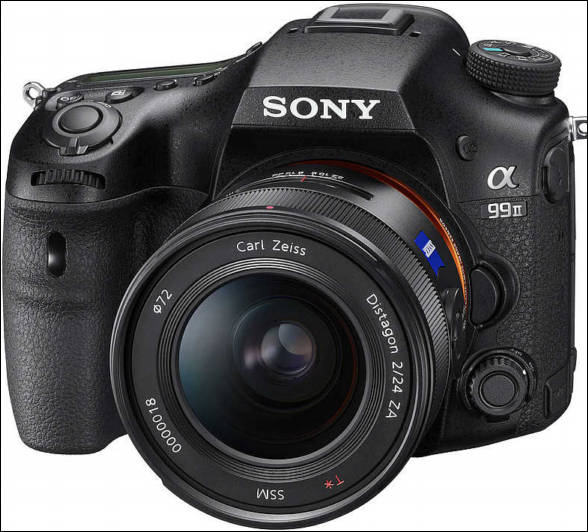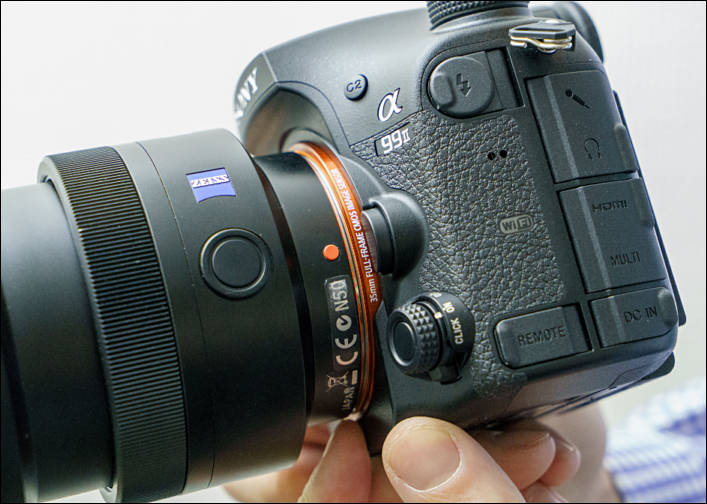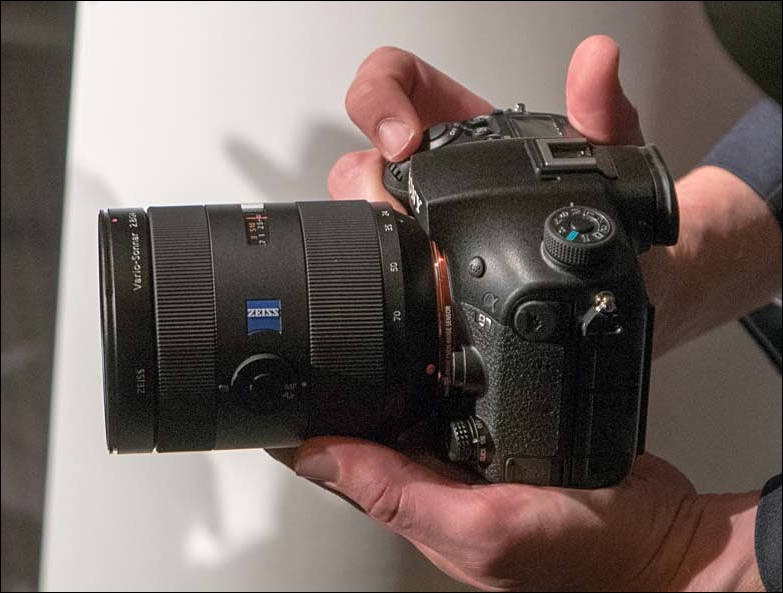
-

Specifications
- 42.2MP BSI-CMOS without AA filter
- BIONZ X LSI
- 5-axis sensor based IS
- 4K video at 100Mbit
- APS-C video mode
- S&Q Motion in Full HD at 1-120 fps
- S-Log2 and S-Log3 profiles and 4:2:2 output over HDMI
- Peaking and zebra
- 12 fps burst shooting, 8 fps with AF almost without EVF blackout
- 399 Phase Detection AF points, 79 cross-type on sensor points
- 300,000 shutter lifespan
- XGA OLED viewfinder, 0.78x magnification
- 3.0" 1,2mdot Tilting LCD Monitor
- Dual SD card slots
- Built-In Wi-Fi & NFC
- $3199
- Available for preorder at https://www.amazon.com/Sony-42-4MP-Digital-Camera-ILCA99M2/dp/B01LYKDVU9/
- Shipping in November
-
PR
Sony Electronics, a worldwide leader in digital imaging and the world’s largest image sensor manufacturer, has today introduced their new flagship A-mount camera, the α99 II.
Reaffirming Sony’s commitment to produce industry leading A-mount cameras, the impressive new camera combines the best of many of their latest digital imaging innovations including a new Hybrid Phase Detection AF system with exclusive Sony A-mount features such as Translucent Mirror Technology™. The result is a supremely specified, professional level camera that will be appealing to a variety of professional and enthusiast photographers.
“We are continuing to innovate with each new camera body, lens and accessory that we bring to market, offering compelling choices to both existing and prospective users of the Sony α system” said Neal Manowitz, Vice President of Digital Imaging at Sony Electronics. “With the α99 II, we’re delivering an industry-leading level of performance to A-mount owners and enthusiasts. Its powerful combination of speed and resolution is simply unmatched in today’s market.”
Redefining Autofocus and Speed
The new α99 II camera is Sony’s first full-frame camera to feature the acclaimed 4D Focus system, bringing a supreme level of AF performance to Sony’s A-mount line-up. The Hybrid Phase Detection AF system is enabled by combining a precision 79-point3 dedicated phase detection AF sensor with 399 focal plane phase detection AF points4 to produce a 79 hybrid cross AF point1 array. This enables incredibly precise autofocus performance and advanced subject tracking of any high-speed moving objects across the frame. In addition Translucent Mirror Technology, with no moving mirror, ensures steady, continuous AF operation and live image preview during both still image and video shooting. The precision AF system also performs exceptionally in low-light conditions, as it will function properly in brightness levels as low as EV-45 and in dark locations where most other cameras struggle.
In addition to its advanced autofocusing, the α99 II has been designed to allow for high resolution, continuous shooting at high frame rates. The camera features a new front-end LSI that works with the image sensor, BIONZ X® image processing engine and a newly designed shutter unit to enable continuous shooting at impressive speeds of up to 12fps2with AF/AE tracking6. Thanks to a large buffer, these shots can be viewed immediately after shooting, even when in high-speed continuous shooting mode. Additionally, if these high-speed shots are being taken indoors under artificial lighting, the camera can automatically detect flicker and time the shutter accordingly to minimize its effect on the resulting images7.
The new α99 II also has the ability to deliver continuous live shooting at up to 8 fps 8 with AF/AE tracking and minimal display lag thanks to overall improvements in the EVF algorithm. This offers photographers a shooting experience that closely mimics that of an optical viewfinder, while still offering all of the benefits of an electronic viewfinder including a live preview of exposure, white balance and several other camera settings. This continuous live view shooting can be set in 3 stages to match a variety of subjects: 8 fps, 6 fps and 4 fps.
Pixel Power
The back-illuminated full-frame 42.4MP9 Exmor R CMOS sensor in the new α99 II model features a gapless-on-chip design that allows for fast readout of large volumes of data and maximizes light gathering ability. The net result is very high sensitivity with low noise, wide dynamic range and 42.4MP resolution across an ISO range of 100-25600, expandable to ISO 50 – 102,40010.
The new camera has also been designed without an optical low-pass filter, ensuring that all of the finest natural details and textures can be captured with unprecedented depth and realism. Both compressed and uncompressed RAW files are readily available based on user preferences.
5-axis SteadyShot™ INSIDE Image Stabilization
Sony has designed a new in-body 5 axis image stabilization system for A-mount cameras that debuts for the first time in the α99 II model. Having proven to be incredibly popular in the ɑ7 II series of cameras, this five axis system effectively detects and compensates for movement in all axes including X and Y, pitch and yaw and camera roll, and ensures that all captured content is crisp and blur-free. The new stabilization system provides a shutter speed advantage of 4.5 steps11, ensuring the full potential of the 42.4MP sensor can be realized. Also, with a simple half press of the shutter button, the effect of this the image stabilization can be monitored in the viewfinder or on the LCD screen, allowing framing and focus to be accurately checked and continually monitored.
Improved design and operability
Based upon feedback from professional users, the design of new α99 II has noticeably evolved compared to its predecessor. The new model is 8% smaller than the original ɑ99 and features a newly designed grip, magnesium alloy body, dual SD card slots12 and dust and moisture resistance13.
The α99 II also features a new shutter unit that has an estimated life of more than 300,000 operations14, as well as an XGA OLED Tru-finder with a ZEISS® T* Coating that offers a powerful 0.78x magnification and delivers outstanding clarify from corner to corner. The viewfinder also has a fluorine coating on the outer lens to prevent fingerprints, dust, water, oil and dirt from sticking, ensuring a clear view.
The silent Multi Controller introduced in the original ɑ99 has been improved as well, as it now offers a click-stop ON/OFF switch in addition to allowing control of aperture, shutter speed, ISO, exposure compensation, AF area, AF mode and other settings. The α99 II also offers location data acquisition via a Bluetooth15 connection to a compatible mobile device and an updated menu structure to deliver a smoother navigational experience.
Movie Magic
For the first time in a Sony A-mount camera, the α99 II has the ability to record 4K video internally with full pixel readout and no pixel binning through usage of the professional friendly XAVC S format. The camera is capable of recording high quality footage at 100Mbps for 4K recording, and utilizing the full width of the large, full-frame image sensor in doing so. It also offers a new ‘Slow and Quick’ mode18 (S&Q) that supports both slow motion and quick motion. In this mode, frame rates from 1 fps to 120 fps can be selected in 8 steps for up to 60x quick motion and 5x slow motion recording19.
A host of other features for professional movie production workflow are also included in the α99 II such as picture profiles, time code and clean HDMI output as well as gamma assist for real time S-Log monitoring and a zebra mode for easier exposure adjustment. S-Log3 and S-Log2 gamma are both included as well.
Pricing and Availability
The Sony α99 II full-frame interchangeable lens camera will ship this November to authorized Sony retailers throughout North America and will be sold for about $3,200 US and $4,000 CA.
-
Videos
-
Is max bitrate for S&Q motion really 12mbps... (watched above video) If so... it's another case of "almost good"
-
Even if true it is easy to fix by firmware update.
-
Awesome beast. The slow motion its amazing and very clean.
-
Wants this.
-
Time limit on video?
-
This looks like a great camera! I am considering switching systems from Nikon to Sony but have some reservations. This would be primarily for photography.. My concern is basically about lens choices. Does anybody on this forum have any experience with the Sony A-Mount?
-
Reasonable price for a 42 megapixel camera also curious about the buffer. Might be good for sports too (8fps) if the focusing locks on and such?? I really like Nikon but Sony is really bringing it. I also prefer an EVF in comparison to an optical viewfinder. Changing settings like aperture, iso etc and shooting with an ND filter is so much easier with a EVF especially if you go past a 4 stop ND.
-
Last dinosaur. Big one, with large tooth, but lonely.
-
Hands-ons and previews


 img2262.jpg707 x 504 - 60K
img2262.jpg707 x 504 - 60K -
The news shooter interview hints at there being autofocus limitations in manual mode. Or potentially that you can't go full manual mode with autofocus. I'm wondering if the a99ii behaves like a fs700 with la-ea2 a mount adaptor where aperture is fixed to f3.5 or wide-open during autofocus.
It's a silly limitation. Still useful from time to time but if you're as limited on the a99ii the e mount cameras will have a real advantage with video af.
-
The A7RII sensor?
-
Menu
-
You make a good point. Even if you can't use the full hybrid af system in video the on sensor af should work just like in a7 bodies. Hopefully...
The f3.5 limitation is with the PDF points that get light from the mirror in the adaptor. Because the a99 has the same mirror tech I wondered if it would be similar. I of course hope that's not the case.
-
Seems previous DSLT cameras did not have af in M mode video shooting. It sounds like this could be the limitation NewsShooter speaks of. That would be a real shame. As part of the appeal to me is face tracking with manual exposure like with the A7 series cameras.
Technically with the new hardware I don't see why this limitation would still exist.
Howdy, Stranger!
It looks like you're new here. If you want to get involved, click one of these buttons!
Categories
- Topics List23,993
- Blog5,725
- General and News1,354
- Hacks and Patches1,153
- ↳ Top Settings33
- ↳ Beginners256
- ↳ Archives402
- ↳ Hacks News and Development56
- Cameras2,368
- ↳ Panasonic995
- ↳ Canon118
- ↳ Sony156
- ↳ Nikon96
- ↳ Pentax and Samsung70
- ↳ Olympus and Fujifilm102
- ↳ Compacts and Camcorders300
- ↳ Smartphones for video97
- ↳ Pro Video Cameras191
- ↳ BlackMagic and other raw cameras116
- Skill1,960
- ↳ Business and distribution66
- ↳ Preparation, scripts and legal38
- ↳ Art149
- ↳ Import, Convert, Exporting291
- ↳ Editors191
- ↳ Effects and stunts115
- ↳ Color grading197
- ↳ Sound and Music280
- ↳ Lighting96
- ↳ Software and storage tips266
- Gear5,420
- ↳ Filters, Adapters, Matte boxes344
- ↳ Lenses1,582
- ↳ Follow focus and gears93
- ↳ Sound499
- ↳ Lighting gear314
- ↳ Camera movement230
- ↳ Gimbals and copters302
- ↳ Rigs and related stuff273
- ↳ Power solutions83
- ↳ Monitors and viewfinders340
- ↳ Tripods and fluid heads139
- ↳ Storage286
- ↳ Computers and studio gear560
- ↳ VR and 3D248
- Showcase1,859
- Marketplace2,834
- Offtopic1,320










